Dell E31S User Manual

Dell PowerEdge R730
Owner's Manual
Regulatory Model: E31S Series
Regulatory Type: E31S001

Notes, cautions, and warnings
NOTE: A NOTE indicates important information that helps you make better use of your computer.
CAUTION: A CAUTION indicates either potential damage to hardware or loss of data and tells you how to avoid the problem.
WARNING: A WARNING indicates a potential for property damage, personal injury, or death.
Copyright © 2015 Dell Inc. All rights reserved. This product is protected by U.S. and international copyright and intellectual property laws. Dell™ and the Dell logo are trademarks of Dell Inc. in the United States and/or other jurisdictions. All other marks and names mentioned herein may be trademarks of their respective companies.
2015 - 08
Rev. A01
Contents |
|
1 About the PowerEdge R730 systems................................................................. |
9 |
Supported configurations on PowerEdge R730 systems.................................................................... |
9 |
Front panel features and indicators...................................................................................................... |
9 |
LCD panel features.............................................................................................................................. |
13 |
Home screen................................................................................................................................. |
14 |
Setup menu.................................................................................................................................... |
14 |
View menu..................................................................................................................................... |
14 |
Hard drive indicator codes.................................................................................................................. |
15 |
iDRAC Direct LED indicator codes...................................................................................................... |
16 |
Quick Sync indicator codes................................................................................................................. |
17 |
Back panel features and indicators..................................................................................................... |
18 |
NIC indicator codes............................................................................................................................ |
20 |
Power supply unit indicator codes..................................................................................................... |
20 |
Documentation matrix........................................................................................................................ |
23 |
Quick Resource Locator .................................................................................................................... |
24 |
2 Performing initial system configuration ....................................................... |
25 |
Setting up your system....................................................................................................................... |
25 |
Setting up and configuring the iDRAC IP address ............................................................................ |
25 |
Logging in to iDRAC............................................................................................................................ |
25 |
Methods of installing the operating system....................................................................................... |
26 |
Managing your system remotely........................................................................................................ |
26 |
Downloading drivers and firmware.................................................................................................... |
26 |
3 Pre-operating system management applications........................................ |
28 |
Navigation keys................................................................................................................................... |
28 |
About System Setup............................................................................................................................ |
29 |
Entering System Setup.................................................................................................................. |
29 |
System Setup Main Menu.............................................................................................................. |
29 |
System BIOS screen...................................................................................................................... |
29 |
System Information screen........................................................................................................... |
30 |
Memory Settings screen................................................................................................................ |
31 |
Processor Settings screen............................................................................................................. |
31 |
SATA Settings screen..................................................................................................................... |
33 |
Boot Settings screen..................................................................................................................... |
36 |
Network Settings screen............................................................................................................... |
37 |
Integrated Devices screen............................................................................................................. |
37 |
Serial Communication screen...................................................................................................... |
38 |
3
System Profile Settings screen...................................................................................................... |
39 |
System Security Settings screen................................................................................................... |
40 |
Miscellaneous Settings screen...................................................................................................... |
42 |
About Boot Manager........................................................................................................................... |
43 |
Entering Boot Manager................................................................................................................. |
43 |
Boot Manager main menu............................................................................................................ |
43 |
Changing the boot order.................................................................................................................... |
43 |
Choosing the system boot mode...................................................................................................... |
44 |
Assigning a system and/or setup password....................................................................................... |
44 |
Using your system password to secure your system........................................................................ |
45 |
Deleting or changing an existing System password or Setup password.......................................... |
45 |
Operating with a setup password enabled........................................................................................ |
46 |
Embedded system management....................................................................................................... |
46 |
iDRAC Settings utility.......................................................................................................................... |
46 |
Entering the iDRAC settings utility................................................................................................ |
46 |
Changing the Thermal Settings.................................................................................................... |
47 |
4 Installing and removing system components............................................... |
48 |
Safety instructions............................................................................................................................... |
48 |
Before working inside your system.................................................................................................... |
48 |
After working inside your system....................................................................................................... |
48 |
Recommended tools.......................................................................................................................... |
49 |
Front bezel (optional).......................................................................................................................... |
49 |
Removing the front bezel............................................................................................................. |
49 |
Installing the front bezel................................................................................................................ |
51 |
Removing the system cover................................................................................................................ |
51 |
Installing the system cover................................................................................................................. |
52 |
Inside the system................................................................................................................................. |
53 |
Cooling shroud................................................................................................................................... |
54 |
Removing the cooling shroud...................................................................................................... |
54 |
Installing the cooling shroud........................................................................................................ |
55 |
Cooling fans........................................................................................................................................ |
55 |
Removing a cooling fan................................................................................................................ |
55 |
Installing a cooling fan.................................................................................................................. |
56 |
Cooling fan assembly.......................................................................................................................... |
57 |
Removing the cooling fan assembly............................................................................................. |
57 |
Installing the cooling fan assembly.............................................................................................. |
58 |
System memory.................................................................................................................................. |
59 |
General memory module installation guidelines......................................................................... |
61 |
Mode-specific guidelines.............................................................................................................. |
62 |
Sample memory configurations................................................................................................... |
63 |
Removing memory modules........................................................................................................ |
66 |
4
Installing memory modules.......................................................................................................... |
67 |
Heat sink and processors.................................................................................................................... |
69 |
Removing a heat sink.................................................................................................................... |
69 |
Removing a processor.................................................................................................................. |
70 |
Installing a heat sink...................................................................................................................... |
73 |
Installing a processor..................................................................................................................... |
75 |
PCIe card holder.................................................................................................................................. |
76 |
Removing the PCIe card holder.................................................................................................... |
76 |
Installing the PCIe card holder...................................................................................................... |
77 |
Opening and closing the PCIe card holder latch......................................................................... |
78 |
Cable retention bracket...................................................................................................................... |
78 |
Removing the cable retention bracket......................................................................................... |
78 |
Installing the cable retention bracket........................................................................................... |
79 |
Integrated storage controller card..................................................................................................... |
80 |
Removing the integrated storage controller card....................................................................... |
80 |
Installing the integrated storage controller card.......................................................................... |
81 |
Expansion cards and expansion card risers....................................................................................... |
82 |
Expansion card installation guidelines......................................................................................... |
82 |
Removing an expansion card from expansion card riser 2 or 3................................................. |
83 |
Installing an expansion card into the expansion card riser 2 or 3............................................... |
85 |
Removing an expansion card from the expansion card riser 1................................................... |
85 |
Installing an expansion card into the expansion card riser 1....................................................... |
87 |
Removing the riser 1 blank............................................................................................................ |
87 |
Installing the riser 1 blank............................................................................................................. |
88 |
Removing expansion card risers................................................................................................... |
88 |
Installing expansion card risers..................................................................................................... |
95 |
GPU card installation guidelines................................................................................................... |
95 |
Removing a GPU card................................................................................................................... |
95 |
Installing a GPU card..................................................................................................................... |
97 |
Internal dual SD module (optional)..................................................................................................... |
97 |
Removing an internal SD card...................................................................................................... |
97 |
Installing an internal SD card........................................................................................................ |
98 |
Removing the optional internal dual SD module........................................................................ |
98 |
Installing the optional internal dual SD module ....................................................................... |
100 |
Network daughter card.................................................................................................................... |
100 |
Removing the network daughter card ...................................................................................... |
100 |
Installing the network daughter card......................................................................................... |
102 |
Internal USB memory key (optional)................................................................................................ |
102 |
Replacing the internal USB key................................................................................................... |
102 |
System battery................................................................................................................................... |
103 |
Replacing the system battery..................................................................................................... |
103 |
Power supply units............................................................................................................................ |
105 |
5
Hot spare feature........................................................................................................................ |
106 |
Removing the power supply unit blank..................................................................................... |
106 |
Installing the power supply unit blank........................................................................................ |
107 |
Removing an AC power supply unit........................................................................................... |
107 |
Installing an AC power supply unit............................................................................................. |
108 |
Wiring instructions for a DC power supply unit......................................................................... |
109 |
Removing a DC power supply unit.............................................................................................. |
111 |
Installing a DC power supply unit............................................................................................... |
112 |
System board..................................................................................................................................... |
113 |
Removing the system board........................................................................................................ |
113 |
Installing the system board.......................................................................................................... |
115 |
Trusted Platform Module.................................................................................................................. |
118 |
Installing the Trusted Platform Module ..................................................................................... |
118 |
Re-enabling the TPM for BitLocker users................................................................................... |
119 |
Re-enabling the TPM for TXT users............................................................................................ |
119 |
Hard drives......................................................................................................................................... |
120 |
Removing a 2.5 inch hard drive blank........................................................................................ |
120 |
Installing a 2.5 inch hard drive blank........................................................................................... |
121 |
Removing a 3.5 inch hard drive blank......................................................................................... |
121 |
Installing a 3.5 inch hard drive blank.......................................................................................... |
122 |
Removing a hot swappable hard drive/SSD............................................................................... |
122 |
Installing a hot-swap hard drive................................................................................................. |
124 |
Removing a hard drive from a hard drive carrier....................................................................... |
125 |
Installing a hard drive into a hard drive carrier........................................................................... |
125 |
Removing a 1.8 inch hard drive blank......................................................................................... |
126 |
Installing a 1.8 inch hard drive blank........................................................................................... |
126 |
Removing a 1.8 inch hard drive from a hard drive carrier.......................................................... |
127 |
Installing a 1.8 inch hard drive into a hard drive carrier............................................................. |
127 |
Hard drive backplane........................................................................................................................ |
128 |
Removing the hard drive backplane .......................................................................................... |
128 |
Installing the hard drive backplane ............................................................................................ |
136 |
Tape backup unit (optional).............................................................................................................. |
137 |
Removing the tape backup unit ................................................................................................. |
137 |
Installing the tape backup unit ................................................................................................... |
138 |
Optical drive (optional)...................................................................................................................... |
139 |
Removing the optical drive......................................................................................................... |
139 |
Installing the optical drive........................................................................................................... |
140 |
SD vFlash media card (optional)....................................................................................................... |
140 |
Replacing an SD vFlash media card............................................................................................ |
140 |
Control panel assembly..................................................................................................................... |
141 |
Removing the control panel ....................................................................................................... |
141 |
Installing the control panel ........................................................................................................ |
144 |
6
5 Troubleshooting your system........................................................................ |
145 |
Safety first—for you and your system............................................................................................... |
145 |
Troubleshooting system startup failure........................................................................................... |
145 |
Troubleshooting external connections............................................................................................ |
145 |
Troubleshooting the video subsystem............................................................................................. |
145 |
Troubleshooting a USB device......................................................................................................... |
145 |
Troubleshooting iDRAC Direct (USB XML configuration)............................................................... |
146 |
Troubleshooting iDRAC Direct (Laptop connection)...................................................................... |
147 |
Troubleshooting a serial I/O device................................................................................................. |
147 |
Troubleshooting an NIC.................................................................................................................... |
147 |
Troubleshooting a wet system......................................................................................................... |
148 |
Troubleshooting a damaged system................................................................................................ |
149 |
Troubleshooting the system battery................................................................................................ |
149 |
Troubleshooting power supply units............................................................................................... |
150 |
Troubleshooting power source problems................................................................................. |
150 |
Power supply unit problems....................................................................................................... |
150 |
Troubleshooting cooling problems.................................................................................................. |
151 |
Troubleshooting cooling fans........................................................................................................... |
151 |
Troubleshooting system memory.................................................................................................... |
152 |
Troubleshooting an internal USB key............................................................................................... |
153 |
Troubleshooting an SD card............................................................................................................. |
153 |
Troubleshooting an optical drive..................................................................................................... |
154 |
Troubleshooting a tape backup unit................................................................................................ |
154 |
Troubleshooting a hard drive............................................................................................................ |
155 |
Troubleshooting a storage controller.............................................................................................. |
156 |
Troubleshooting expansion cards.................................................................................................... |
156 |
Troubleshooting processors............................................................................................................. |
157 |
System messages.............................................................................................................................. |
158 |
Warning messages...................................................................................................................... |
158 |
Diagnostic messages................................................................................................................... |
158 |
Alert messages............................................................................................................................. |
158 |
6 Using system diagnostics................................................................................ |
159 |
Dell Embedded System Diagnostics................................................................................................. |
159 |
When to use the Embedded System Diagnostics...................................................................... |
159 |
Running the Embedded System Diagnostics from Boot Manager............................................ |
159 |
Running the Embedded System Diagnostics from the Dell Lifecycle Controller..................... |
159 |
System diagnostics controls....................................................................................................... |
160 |
7 Jumpers and connectors................................................................................. |
161 |
System board jumper settings........................................................................................................... |
161 |
7
System board jumpers and connectors |
........................................................................................... 162 |
Disabling a forgotten password........................................................................................................ |
164 |
8 Technical specifications.................................................................................. |
165 |
9 Getting help....................................................................................................... |
172 |
Contacting Dell.................................................................................................................................. |
172 |
Locating your system Service Tag.................................................................................................... |
172 |
Documentation feedback................................................................................................................. |
172 |
Quick Resource Locator .................................................................................................................. |
172 |
8

1
About the PowerEdge R730 systems
The Dell PowerEdge R730 systems are rack servers that support up to two Intel Xeon E5-2600 v3 processors, up to 24 DIMMs, and 16 hard drives or solid state drives (SSDs).
Supported configurations on PowerEdge R730 systems
NOTE: Your system supports only internal, hot-swappable hard drives.
Systems |
Configurations |
|
|
Eight-hard drive systems |
Up to eight 3.5-inch hard drives or eight 2.5-inch hard drives. |
Sixteen-hard drive |
Up to sixteen 2.5-inch hard drives. |
systems |
|
Front panel features and indicators
Figure 1. Front panel features and indicators (3.5-inch hard drive chassis)
Item |
Indicator, button, or |
Icon |
Description |
|
connector |
|
|
|
|
|
|
1 |
Power-on indicator, |
|
The power-on indicator lights when the system |
|
power button |
|
power is on. The power button controls the power |
|
|
|
supply output to the system. |
9

Item |
Indicator, button, or |
Icon |
Description |
|
connector |
|
|
|
|
|
|
|
|
|
NOTE: On ACPI-compliant operating systems, |
|
|
|
turning off the system using the power button |
|
|
|
causes the system to perform a graceful |
|
|
|
shutdown before power to the system is |
|
|
|
turned off. |
2 |
NMI button |
|
Used to troubleshoot software and device driver |
|
|
|
errors when running certain operating systems. This |
|
|
|
button can be pressed using the end of a paper clip. |
|
|
|
Use this button only if directed to do so by qualified |
|
|
|
support personnel or by the operating system |
|
|
|
documentation. |
3 |
System identification |
|
The identification buttons on the front and back |
|
button |
|
panels can be used to locate a particular system |
|
|
|
within a rack. When one of these buttons is pressed, |
|
|
|
the LCD panel on the front and the system status |
|
|
|
indicator on the back flashes until one of the |
|
|
|
buttons is pressed again. |
|
|
|
Press to toggle the system ID on and off. |
|
|
|
If the system stops responding during POST, press |
|
|
|
and hold the system ID button for more than five |
|
|
|
seconds to enter BIOS progress mode. |
|
|
|
To reset iDRAC (if not disabled in F2 iDRAC setup) |
|
|
|
press and hold the button for more than 15 |
|
|
|
seconds. |
4 |
Video connector |
|
Enables you to connect a display to the system. |
5 |
LCD menu buttons |
|
Enable you to navigate the control panel LCD |
|
|
|
menu. |
6 |
Information tag |
|
A slide-out label panel which allows you to record |
|
|
|
system information such as Service Tag, NIC, MAC |
|
|
|
address, and so on, as per your need. |
7 |
LCD panel |
|
Displays system ID, status information, and system |
|
|
|
error messages. |
|
|
|
For more information, see LCD panel features. |
8Hard drives
9USB management port/ iDRAC Direct
Up to eight 3.5-inch hot-swappable drives.
Enables you to connect USB devices to the system or provides access to the iDRAC Direct features. For more information, see the Integrated Dell Remote Access Controller User’s Guide at Dell.com/ idracmanuals. The USB management port is USB 2.0-compliant.
10
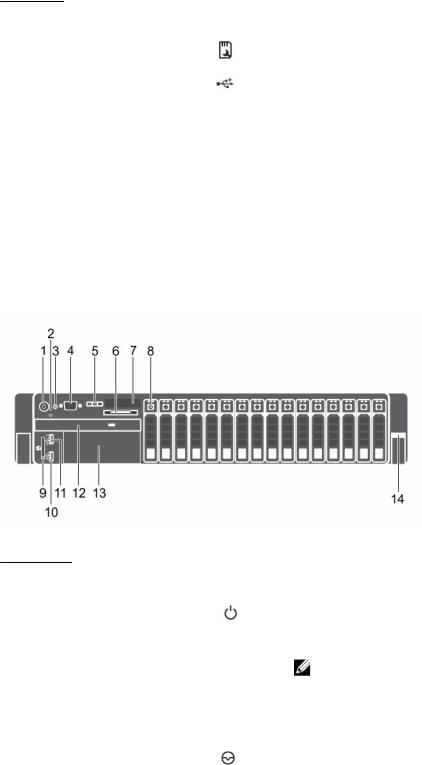
Item |
Indicator, button, or |
Icon |
Description |
|
connector |
|
|
|
|
|
|
10 |
vFlash media card slot |
|
Enables you to insert a vFlash media card. |
11 |
USB connector |
|
Enables you to connect USB devices to the system. |
|
|
|
The ports are USB 2.0-compliant. |
12Optical drive (optional)
13Quick Sync (optional)
One optional SATA DVD-ROM drive or DVD+/-RW drive.
Indicates a Quick Sync enabled system. The Quick Sync feature is optional and requires a Quick Sync bezel. This feature allows management of the system using mobile devices. This feature aggregates hardware or firmware inventory and various system level diagnostic and error information which can be used in troubleshooting the system. For more information, see the Integrated Dell Remote Access Controller User’s Guide at Dell.com/idracmanuals.
Figure 2. Front panel features and indicators (2.5-inch hard drive/SSD chassis)
Item |
Indicator, button, or |
Icon |
Description |
|
connector |
|
|
|
|
|
|
1 |
Power-on indicator, |
|
The power-on indicator lights when the system |
|
power button |
|
power is on. The power button controls the power |
|
|
|
supply output to the system. |
|
|
|
NOTE: On ACPI-compliant operating systems, |
|
|
|
turning off the system using the power button |
|
|
|
causes the system to perform a graceful |
|
|
|
shutdown before power to the system is |
|
|
|
turned off. |
2 |
NMI button |
|
Used to troubleshoot software and device driver |
|
|
|
errors when running certain operating systems. |
11

Item |
Indicator, button, or |
Icon |
Description |
|
connector |
|
|
|
|
|
|
|
|
|
This button can be pressed using the end of a |
|
|
|
paper clip. |
|
|
|
Use this button only if directed to do so by |
|
|
|
qualified support personnel or by the operating |
|
|
|
system documentation. |
3 |
System identification |
|
The identification buttons on the front and back |
|
button |
|
panels can be used to locate a particular system |
|
|
|
within a rack. When one of these buttons is |
|
|
|
pressed, the LCD panel on the front and the |
|
|
|
system status indicator on the back flashes until |
|
|
|
one of the buttons is pressed again. |
|
|
|
Press to toggle the system ID on and off. |
|
|
|
If the system stops responding during POST, press |
|
|
|
and hold the system ID button for more than five |
|
|
|
seconds to enter BIOS progress mode. |
|
|
|
To reset iDRAC (if not disabled in F2 iDRAC setup) |
|
|
|
press and hold the button for more than 15 |
|
|
|
seconds. |
4 |
Video connector |
|
Enables you to connect a display to the system. |
5 |
LCD menu buttons |
|
Enable you to navigate the control panel LCD |
|
|
|
menu. |
6 |
Information tag |
|
A slide-out label panel which allows you to record |
|
|
|
system information such as Service Tag, NIC, MAC |
|
|
|
address, and so on, as per your need. |
7 |
LCD panel |
|
Displays system ID, status information, and system |
|
|
|
error messages. |
|
|
|
For more information, see LCD panel features. |
8Hard drives
9vFlash media card slot
10USB connector
11USB management port/ iDRAC Direct
Up to sixteen 2.5-inch hot-swappable hard drives.
Enables you to insert a vFlash media card.
Enables you to connect USB devices to the system. The ports are USB 2.0-compliant.
Enables you to connect USB devices to the system or provides access to the iDRAC Direct features. For more information, see the Integrated Dell Remote Access Controller User’s Guide at
Dell.com/idracmanuals. The USB management port is USB 2.0-compliant.
12 |
Optical drive (optional) |
One optional SATA DVD-ROM drive or DVD+/-RW |
|
|
drive. |
12

Item |
Indicator, button, or |
Icon |
Description |
|
connector |
|
|
|
|
|
|
13 |
Tape drive slot (optional) |
|
One optional 3.5-inch tape backup unit. |
14 |
Quick Sync (optional) |
|
Indicates a Quick Sync enabled system. The Quick |
Sync feature is optional and requires a Quick Sync bezel. This feature allows management of the system using mobile devices. This feature aggregates hardware or firmware inventory and various system level diagnostic and error information which can be used in troubleshooting the system. For more information, see the Integrated Dell Remote Access Controller User’s Guide at Dell.com/idracmanuals.
LCD panel features
The LCD panel of your system provides system information and status and error messages to indicate if the system is operating correctly or if the system needs attention. For more information on error messages, see the Dell Event and Error Messages Reference Guide at Dell.com/
openmanagemanuals >OpenManage software.
•The LCD backlight lights blue during normal operating conditions and lights amber to indicate an error condition.
•The LCD backlight is off when the system is in standby mode and can be turned on by pressing either the Select, Left, or Right button on the LCD panel.
•The LCD backlight remains off if LCD messaging is turned off through the iDRAC utility, the LCD panel, or other tools.
Figure 3. LCD panel features
Item |
Button |
Description |
|
|
|
1 |
Left |
Moves the cursor back in one-step increments. |
2 |
Select |
Selects the menu item highlighted by the cursor. |
3 |
Right |
Moves the cursor forward in one-step increments. |
|
|
During message scrolling: |
• Press and hold the button to increase scrolling speed.
• Release the button to stop.
13

Item |
Button |
Description |
|
|
|
NOTE: The display stops scrolling when the button is released. After 45 seconds of inactivity the display starts scrolling.
Home screen
The Home screen displays user-configurable information about the system. This screen is displayed during normal system operation when there are no status messages or errors. When the system is in standby mode, the LCD backlight turns off after five minutes of inactivity if there are no error messages. Press one of the three navigation buttons (Select, Left, or Right) to view the Home screen.
To navigate to the Home screen from another menu, continue to select the up arrow  until the Home icon
until the Home icon  is displayed, and then select the Home icon.
is displayed, and then select the Home icon.
From the Home screen, press the Select button to enter the main menu.
Setup menu
NOTE: When you select an option in the Setup menu, you must confirm the option before proceeding to the next action.
Option |
Description |
iDRAC |
Select DHCP or Static IP to configure the network mode. If Static IP is selected, |
|
the available fields are IP, Subnet (Sub), and Gateway (Gtw). Select Setup DNS to |
|
enable DNS and to view domain addresses. Two separate DNS entries are available. |
Set error |
Select SEL to view LCD error messages in a format that matches the IPMI |
|
description in the SEL. This is useful when trying to match an LCD message with an |
|
SEL entry. |
|
Select Simple to view LCD error messages in a simplified user-friendly description. |
|
For more information about error messages, see the Dell Event and Error Messages |
|
Reference Guide at Dell.com/openmanagemanuals > OpenManage software. |
Set home |
Select the default information to be displayed on the Home screen. See View menu |
|
for the options and option items that can be set as the default on the Home |
|
screen. |
View menu
NOTE: When you select an option in the View menu, you must confirm the option before proceeding to the next action.
Option |
Description |
iDRAC IP |
Displays the IPv4 or IPv6 addresses for iDRAC8. Addresses include DNS (Primary |
|
and Secondary), Gateway, IP, and Subnet (IPv6 does not have Subnet). |
MAC |
Displays the MAC addresses for iDRAC, iSCSI, or Network devices. |
14
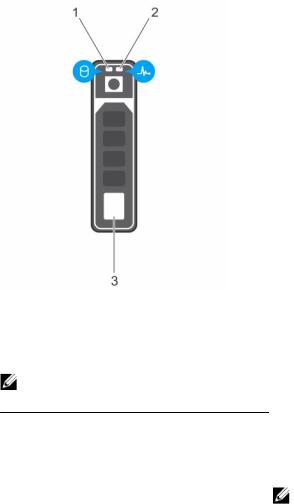
Option |
Description |
Name |
Displays the name of the Host, Model, or User String for the system. |
Number |
Displays the Asset tag or the Service tag for the system. |
Power |
Displays the power output of the system in BTU/hr or Watts. The display format can |
|
be configured in the Set home submenu of the Setup menu. |
Temperature |
Displays the temperature of the system in Celsius or Fahrenheit. The display format |
|
can be configured in the Set home submenu of the Setup menu. |
Hard drive indicator codes
Figure 4. Hard drive indicators
1. |
hard drive activity indicator |
2. |
hard drive status indicator |
3.hard drive
NOTE: If the hard drive is in Advanced Host Controller Interface (AHCI) mode, the status indicator (on the right side) does not function and remains off.
Drive-status indicator pattern (RAID only) |
Condition |
|
|
Blinks green two times per second |
Identifying drive or preparing for removal. |
Off |
Drive ready for insertion or removal. |
|
NOTE: The drive status indicator remains off until |
|
all hard drives are initialized after the system is |
|
turned on. Drives are not ready for insertion or |
|
removal during this time. |
Blinks green, amber, and turns off |
Predicted drive failure |
15
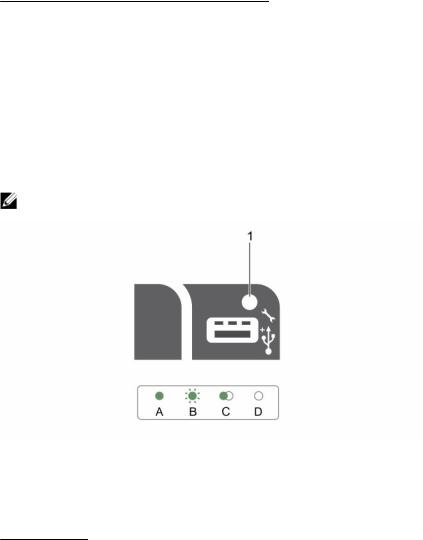
Drive-status indicator pattern (RAID only) |
Condition |
|
|
Blinks amber four times per second |
Drive failed |
Blinks green slowly |
Drive rebuilding |
Steady green |
Drive online |
Blinks green three seconds, amber three |
Rebuild aborted |
seconds, and turns off six seconds |
|
iDRAC Direct LED indicator codes
NOTE: The iDRAC Direct LED indicator does not light up for the USB mode.
Figure 5. iDRAC Direct LED indicator
1.iDRAC Direct status indicator
The following table displays iDRAC Direct activity when configuring iDRAC Direct by using the management port (USB XML Import).
Convention |
iDRAC Direct |
Condition |
|
LED indicator |
|
|
pattern |
|
|
|
|
A |
Green |
Lights green for a minimum of two seconds at the beginning and |
|
|
end of a file transfer. |
B |
Flashing green |
Indicates file transfer or any operation tasks. |
C |
Green and turns |
Indicates that the file transfer is complete. |
|
off |
|
D |
Not lit |
Indicates that the USB is ready to be removed or that a task is |
|
|
complete. |
The following table displays iDRAC Direct activity when configuring iDRAC Direct by using your laptop and cable (Laptop Connect).
16

iDRAC Direct LED |
Condition |
indicator pattern |
|
|
|
Solid green for two |
Indicates that the laptop is connected. |
seconds |
|
Flashing green (on |
Indicates that the laptop connected is recognized. |
for two seconds and |
|
off for two seconds) |
|
Turns off |
Indicates that the laptop is unplugged. |
Quick Sync indicator codes
Figure 6. Quick Sync indicator codes |
|
|
|
1. |
Quick Sync status indicator |
2. |
Quick Sync activation button |
|
|
||
Power indicator pattern |
Condition |
||
|
|
||
Slow blink |
Indicates that Quick Sync is waiting to be configured |
||
|
|
from iDRAC. |
|
Solid
Blinks three times rapidly and then turns off
Blinks continuously when the mobile device touches the antenna
Blinks rapidly five times and turns off for one second when the activation button is pressed. This pattern is repeated until the activation button is pressed again.
Off
Indicates that Quick Sync is ready to transfer.
Indicates that the Quick Sync feature is disabled from iDRAC.
Indicates data transfer activity.
Indicates that the Quick Sync hardware is not responding properly. Reseat the bezel. If the problem persists, see Getting help.
Indicates that the Quick Sync feature is turned off. Use the activation button to activate it. If pressing the activation button does not turn on the LEDs, it
17
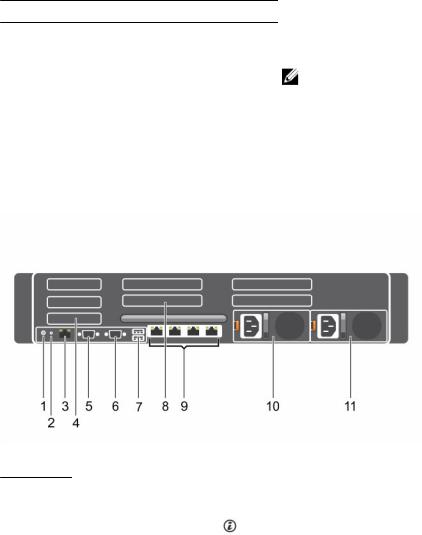
Power indicator pattern |
Condition |
indicates that power is not delivered to the Quick Sync bezel.
NOTE: For security purposes, Quick Sync turns off after thirty seconds of inactivity after the activation button is pressed. Once timed-out, the user is expected to press the activation button again to activate Quick Sync.
Back panel features and indicators
Figure 7. Back panel features and indicators
Item |
Indicator, button, or |
Icon |
Description |
|
connector |
|
|
|
|
|
|
1 |
System identification |
|
The identification buttons on the front and back |
|
button |
|
panels can be used to locate a particular system |
|
|
|
within a rack. |
|
|
|
When one of these buttons is pressed, the LCD |
|
|
|
panel on the front and the system status indicator |
|
|
|
on the back flashes until one of the buttons is |
|
|
|
pressed again. |
|
|
|
Press to toggle the system ID on and off. |
|
|
|
If the system stops responding during POST, press |
|
|
|
and hold the system ID button for more than five |
|
|
|
seconds to enter BIOS progress mode. |
18

Item |
Indicator, button, or |
Icon |
Description |
|
connector |
|
|
2System identification connector
3iDRAC8 Enterprise port
4Half-height PCIe expansion card slot (3)
5Serial connector
6Video connector
7USB connector (2)
8Full-height PCIe expansion card slot (4)
9Ethernet connector (4)
10Power supply unit (PSU1)
11Power supply unit (PSU2)
To reset iDRAC (if not disabled in F2 iDRAC setup) press and hold the button for more than 15 seconds.
Connects the optional system status indicator assembly through the optional cable management arm.
Dedicated management port.
Allows you to connect up to three half-height PCI Express expansion cards.
Allows you to connect a serial device to the system.
Allows you to connect a VGA display to the system.
Allows you to connect USB devices to the system. The ports are USB 3.0-compliant.
Allows you to connect up to four full-height PCI Express expansion cards.
Four integrated 10/100/1000 Mbps NIC connectors
or
Four integrated connectors that include:
•Two 10/100/1000 Mbps NIC connectors
•Two 100 Mbps/1 Gbps/10 Gbps SFP+/10 GbE T connectors
AC |
495 W, 750 W, or 1100 W |
or |
|
DC |
750 W or 1100 W |
19
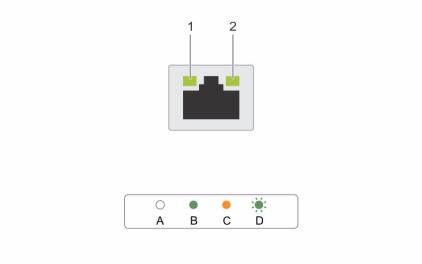
NIC indicator codes
Figure 8. NIC indicators |
|
||
1. |
link indicator |
2. |
activity indicator |
|
|
|
|
Convention |
Indicator |
Indicator code |
|
|
|
|
|
A |
|
Link and activity indicators are off |
The NIC is not connected to the |
|
|
|
network. |
B |
|
Link indicator is green |
The NIC is connected to a valid network |
|
|
|
at its maximum port speed (1 Gbps or 10 |
|
|
|
Gbps). |
C |
|
Link indicator is amber |
The NIC is connected to a valid network |
|
|
|
at less than its maximum port speed. |
D |
|
Activity indicator is blinking green |
Network data is being sent or received. |
Power supply unit indicator codes
Each AC power supply unit (PSU) has an illuminated translucent handle and each DC PSU (when available) has an LED that serves as an indicator to show whether power is present or a power fault has occurred.
20

Figure 9. AC PSU status indicator
1.AC PSU status indicator/handle
Convention |
Power indicator |
Condition |
|
pattern |
|
|
|
|
A |
Green |
A valid power source is connected to the PSU and the PSU is |
|
|
operational. |
B |
Flashing green |
When the firmware of the PSU is being updated, the PSU handle |
|
|
flashes green. |
C |
Flashing green |
When hot-adding a PSU, the PSU handle flashes green five times at |
|
and turns off |
4 Hz rate and turns off. This indicates that there is a PSU mismatch |
|
|
with respect to efficiency, feature set, health status, and supported |
|
|
voltage. Replace the PSU with a PSU that matches the capacity of |
|
|
the other PSU. |
|
|
CAUTION: For AC PSUs, use only PSUs with the Extended |
|
|
Power Performance (EPP) label on the back. Mixing PSUs from |
|
|
previous generations of Dell PowerEdge servers can result in a |
|
|
PSU mismatch condition or failure to power on. |
D |
Flashing amber |
Indicates a problem with the PSU. |
|
|
CAUTION: When correcting a PSU mismatch, replace only the |
|
|
PSU with the flashing indicator. Swapping the PSU to make a |
|
|
matched pair can result in an error condition and unexpected |
|
|
system shutdown. To change from a high output |
|
|
configuration to a low output configuration or vice versa, you |
|
|
must power down the system. |
21
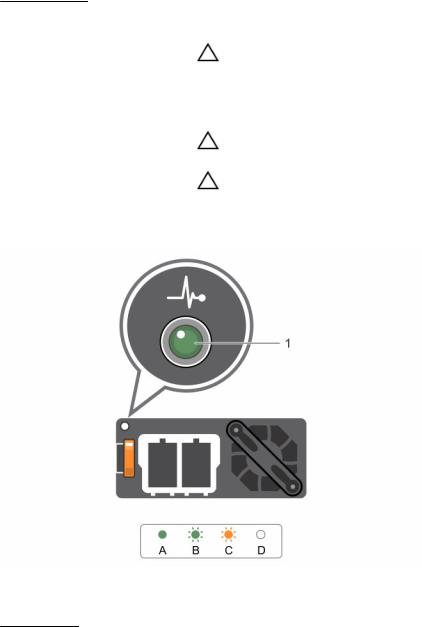
Convention |
Power indicator |
Condition |
|
pattern |
|
|
|
|
|
|
CAUTION: AC PSUs support both 220 V and 110 V input |
|
|
voltages with the exception of Titanium PSUs, which support |
|
|
only 220 V. When two identical PSUs receive different input |
|
|
voltages, they can output different wattages, and trigger a |
|
|
mismatch. |
|
|
CAUTION: If two PSUs are used, they must be of the same type |
|
|
and have the same maximum output power. |
|
|
CAUTION: Combining AC and DC PSUs is not supported and |
|
|
triggers a mismatch. |
E |
Not lit |
Power is not connected. |
Figure 10. DC PSU status indicator
1.DC PSU status indicator
Convention |
Power indicator |
Condition |
|
pattern |
|
|
|
|
A |
Green |
A valid power source is connected to the PSU and that the PSU is |
|
|
operational. |
B |
Flashing green |
When hot-adding a PSU, the PSU indicator flashes green. This |
|
|
indicates that there is a PSU mismatch with respect to efficiency, |
|
|
feature set, health status, and supported voltage. Replace the PSU |
|
|
with a PSU that matches the capacity of the other installed PSU. |
C |
Flashing amber |
Indicates a problem with the PSU. |
22

Convention |
Power indicator |
Condition |
|
pattern |
|
|
|
|
|
|
CAUTION: When correcting a PSU mismatch, replace only |
|
|
the PSU with the flashing indicator. Swapping the PSU to |
|
|
make a matched pair can result in an error condition and |
|
|
unexpected system shutdown. To change from a High |
|
|
Output configuration to a Low Output configuration or vice |
|
|
versa, you must power down the system. |
|
|
CAUTION: AC PSU support both 220 V and 110 V input |
|
|
voltages with the exception of Titanium PSU, which support |
|
|
only 220 V. When two identical PSU receive different input |
|
|
voltages, they can output different wattages, and trigger a |
|
|
mismatch. |
|
|
CAUTION: If two PSU are used, they must be of the same |
|
|
type and have the same maximum output power. |
|
|
CAUTION: Combining AC and DC PSU is not supported and |
|
|
triggers a mismatch. |
D |
Not lit |
Power is not connected. |
Documentation matrix
The documentation matrix provides information on documents that you can refer to for setting up and managing your system.
Table 1. Documentation matrix
To... |
See the... |
|
|
Install your system into a rack |
Rack documentation included with your rack |
|
solution. |
Set up your system and know the system technical specifications
Install the operating system
Getting Started With Your System that shipped with your system or see Dell.com/poweredgemanuals.
Operating system documentation at Dell.com/ operatingsystemmanuals
Get an overview of the Dell Systems Management offerings
Configure and log in to iDRAC, set up managed and management system, know the iDRAC features and troubleshoot by using iDRAC
Know about the RACADM subcommands and supported RACADM interfaces
Launch, enable and disable Dell Lifecycle Controller, know the features, use and troubleshoot Dell Lifecycle Controller
Dell OpenManage Systems Management Overview Guide at Dell.com/openmanagemanuals > OpenManage software
Integrated Dell Remote Access Controller User's
Guide at Dell.com/idracmanuals
RACADM Command Line Reference Guide for iDRAC at Dell.com/idracmanuals
Dell Lifecycle Controller User’s Guide at Dell.com/ idracmanuals
23
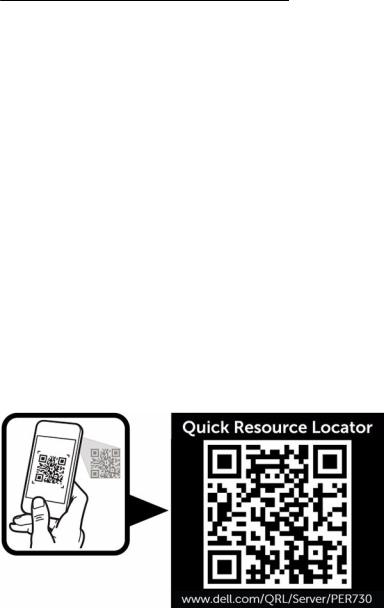
To... |
See the... |
|
|
Use Dell Lifecycle Controller Remote Services |
Dell Lifecycle Controller Remote Services Quick |
|
Start Guide at Dell.com/idracmanuals |
Set up, use, and troubleshoot OpenManage Server |
Dell OpenManage Server Administrator User’s |
Administrator |
Guide at Dell.com/openmanagemanuals > |
|
OpenManage Server Administrator |
Install, use, and troubleshoot OpenManage |
Dell OpenManage Essentials User’s Guide at |
Essentials |
Dell.com/openmanagemanuals > OpenManage |
|
Essentials |
Know the features of the storage controller cards, deploy the cards, and manage the storage subsystem
Storage controller documentation at Dell.com/ storagecontrollermanuals
Check the event and error messages generated by |
Dell Event and Error Messages Reference Guide at |
the system firmware and agents that monitor |
Dell.com/openmanagemanuals > OpenManage |
system components |
software. |
Quick Resource Locator
Use the Quick Resource Locator (QRL) to get immediate access to system information and how-to videos. This can be done by visiting Dell.com/QRL or by using your smartphone or tablet and a model specific Quick Resource (QR) code located on your Dell PowerEdge system. To try out the QR code, scan the following image.
24
2
Performing initial system configuration
After you receive your system, you must set up your system, install the operating system if it is not preinstalled, and set up and configure the system iDRAC IP address.
Setting up your system
1.Unpack the system.
2.Install the system into the rack. For more information about installing the system into the rack, see your system Rack Installation placemat at Dell.com/poweredgemanuals.
3.Connect the peripherals to the system.
4.Connect the system to its electrical outlet.
5.Turn the system on by pressing the power button or by using iDRAC.
6.Turn on the attached peripherals.
Setting up and configuring the iDRAC IP address
You can set up the Integrated Dell Remote Access Controller (iDRAC) IP address by using one of the following interfaces:
•iDRAC Settings utility.
•Dell Lifecycle Controller.
•Dell Deployment Toolkit.
•System LCD panel.
•Quick Sync (optional)
You can configure iDRAC IP using:
•iDRAC Web Interface.
For more information, see the Integrated Dell Remote Access Controller User's Guide.
•Remote Access Controller ADMin (RACADM).
For more information, see the RACADM Command Line Interface Reference Guide and the Integrated Dell Remote Access Controller User's Guide.
•Remote Services that includes Web Services Management (WS-Man). For more information, see the Lifecycle Controller Remote Services Quick Start Guide.
For more information on setting up and configuring iDRAC, see the Integrated Dell Remote Access Controller User's Guide at Dell.com/idracmanuals.
Logging in to iDRAC
You can log in to iDRAC as an iDRAC local user, a Microsoft Active Directory user, or a Lightweight Directory Access Protocol (LDAP) user. You can also log in by using Single Sign-On or a Smart Card. The
25

default user name is root and password is calvin. For more information about logging in to iDRAC and iDRAC licenses, see the Integrated Dell Remote Access Controller User's Guide at Dell.com/ idracmanuals.
You can also access iDRAC by using RACADM. For more information, see the RACADM Command Line Interface Reference Guide and the Integrated Dell Remote Access Controller User's Guide available at
Dell.com/idracmanuals.
Methods of installing the operating system
If the system is shipped without an operating system, install the supported operating system on the system by using one of the following methods:
•Dell Systems Management Tools and Documentation media. See the operating system documentation at Dell.com/operatingsystemmanuals.
•Dell Lifecycle Controller. See the Lifecycle Controller documentation at Dell.com/idracmanuals.
•Dell OpenManage Deployment Toolkit. See the OpenManage documentation at Dell.com/ openmanagemanuals > OpenManage software.
For information on the list of operating systems supported on your system, see the operating systems support matrix at Dell.com/ossupport.
Managing your system remotely
To perform out-of-band systems management using iDRAC, you must configure iDRAC for remote accessibility, set up the management station and managed system, and configure the supported Web browsers. For more information, see the Integrated Dell Remote Access Controller User’s Guide at
Dell.com/idracmanuals.
You can also remotely monitor and manage the server by using the Dell OpenManage Server Administrator (OMSA) software and OpenManage Essentials (OME) systems management console. For more information, see Dell.com/openmanagemanuals > OpenManage software.
Downloading drivers and firmware
It is recommended that you download and install the latest BIOS, drivers, and systems management firmware on your system.
Prerequisites
Ensure that you clear the web browser cache.
Steps
1.Go to Dell.com/support/drivers.
2.In the Product Selection section, enter the Service Tag of your system in the Service Tag or Express Service Code field.
NOTE: If you do not have the Service Tag, select Automatically detect my Service Tag for me to enable the system to automatically detect your Service Tag, or select Choose from a list of all Dell products to select your product from the Product Selection page.
3.Click Get drivers and downloads.
The drivers that are applicable to your selection are displayed.
26
4.Download the drivers that you need to a USB drive, CD, or DVD.
27

3
Pre-operating system management applications
The pre-operating system management applications for your system help you manage different settings and features without booting to the operating system.
Your system has the following pre-operating system management applications:
•System Setup
•Boot Manager
•Dell Lifecycle Controller
•Preboot Execution Environment (PXE)
Navigation keys
The navigation keys can help you quickly access the pre-operating system management applications.
Key |
Description |
F2 |
Enter System Setup. |
F10 |
Enters system services and starts Lifecycle Controller. |
F11 |
Enters Boot Manager. |
F12 |
Enters PXE Boot. |
Page Up |
Moves to the previous screen. |
Page Down |
Moves to the next screen. |
Up arrow |
Moves to the previous field. |
Down arrow |
Moves to the next field. |
Enter |
Enables you to type a value in the selected field (if applicable). |
Spacebar |
Expands or collapses a drop-down list, if applicable. |
Tab |
Moves to the next menu item. |
|
NOTE: This feature is applicable for the standard graphic browser only. |
Esc |
Moves to the previous page until you view the main screen. Pressing Esc in the |
|
main screen exits System BIOS, iDRAC Settings, Device Settings, or Service Tag |
|
Settings, and proceeds with system boot. |
F1 |
Displays the system setup help. |
28

About System Setup
By using the System Setup screen, you can configure the BIOS settings, iDRAC settings, and device settings of your system.
NOTE: Help text for the selected field is displayed in the graphical browser by default. To view the help text in the text browser, press F1.
You can access system setup in two ways:
•Standard graphical browser — The browser is enabled by default.
•Text Browser — The browser is enabled by using Console Redirection.
Entering System Setup
1.Turn on, or restart your system.
2.Press F2 immediately after you see the following message:
F2 = System Setup
If your operating system begins to load before you press F2, wait for the system to finish booting, and then restart your system and try again.
System Setup Main Menu
The System Setup Main Menu screen details are explained as follows:
Option Description
System BIOS |
Enables you to configure BIOS settings. |
iDRAC Settings Enables you to configure iDRAC settings.
The iDRAC settings utility is an interface to set up and configure the iDRAC parameters by using UEFI. You can enable or disable various iDRAC parameters by using the iDRAC settings utility. For more information about this utility, see
Integrated Dell Remote Access Controller User’s Guide at Dell.com/idracmanuals.
Device Settings Enables you to configure device settings.
System BIOS screen
You can use the System BIOS screen to edit specific functions such as boot order, system password, setup password, set the RAID mode, and enable or disable USB ports.
To view the System BIOS screen, click System Setup Main Menu → System BIOS. The System BIOS screen details are explained as follows:
Option |
Description |
System |
Displays information about the system such as the system model name, BIOS |
Information |
version, and Service Tag. |
Memory Settings |
Displays information and options related to the installed memory. |
29
Option Description
Processor Settings Displays information and options related to the processor such as speed, cache size.
SATA Settings |
Displays options to enable or disable the integrated SATA controller and ports. |
Boot Settings |
Displays options to specify the boot mode (BIOS or UEFI). Enables you to modify |
|
UEFI and BIOS boot settings. |
Network Settings |
Displays options to change the network settings. |
Integrated |
Displays options to manage integrated device controllers and ports, and specify |
Devices |
related features and options. |
Serial |
Displays options to manage the serial ports, and specify related features and |
Communication |
options. |
System Profile |
Displays options to change the processor power management settings, memory |
Settings |
frequency, and so on. |
System Security |
Displays options to configure the system security settings, such as system |
|
password, setup password, TPM security. It also manages the power and NMI |
|
buttons on the system. |
Miscellaneous |
Displays options to change the system date, time, and so on. |
Settings |
|
System Information screen
You can use the System Information screen to view system properties such as Service Tag, system model name, and the BIOS version.
To view the System Information screen, click System Setup Main Menu → System BIOS → System Information.
The System Information screen details are explained as follows:
Option |
Description |
System Model |
Displays the system model name. |
Name |
|
System BIOS |
Displays the BIOS version installed on the system. |
Version |
|
System |
Displays the current version of the Management Engine firmware. |
Management |
|
Engine Version |
|
System Service |
Displays the system Service Tag. |
Tag |
|
System |
Displays the name of the system manufacturer. |
Manufacturer |
|
System |
Displays the contact information of the system manufacturer. |
Manufacturer |
|
Contact |
|
Information |
|
System CPLD |
Displays the current version of the system complex programmable logic device |
Version |
(CPLD) firmware. |
30
